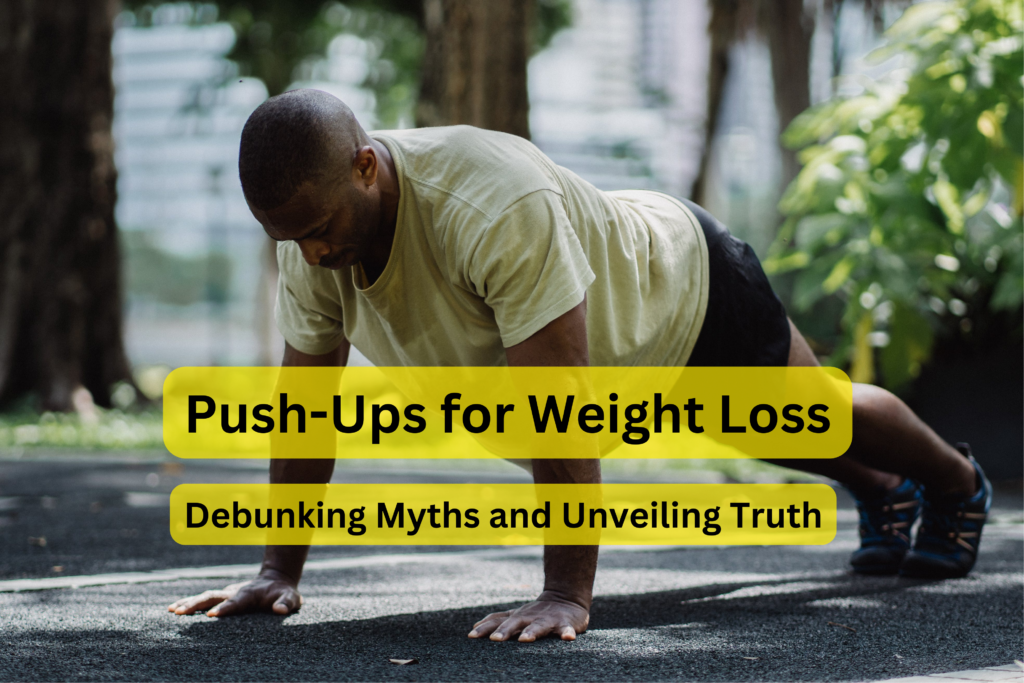Push-ups, the ubiquitous exercise etched into childhood gymnasiums and military boot camps, hold a special place in the fitness pantheon. Requiring no equipment and scalable for all fitness levels, they’re a testament to the power of bodyweight training. But when it comes to weight loss, the question arises: do push-ups make you lose weight?
The answer, like most things in fitness, isn’t a simple binary. Push-ups offer a potent blend of benefits that contribute to weight loss, but they’re not a magic bullet. Let’s delve into the science behind push-ups and their impact on your physique.
Calorie Combustion Push-Ups as a Furnace
Every rep of a push-up ignites a mini-inferno within your body, burning precious calories. The beauty of push-ups lies in their compound nature. They engage multiple muscle groups simultaneously, including your chest, shoulders, triceps, core, and even your legs. This multi-muscle activation translates to higher calorie expenditure compared to isolation exercises that target a single muscle group.
The exact number of calories torched per push-up depends on several factors, including:
- Your body weight: Heavier individuals burn more calories during exercise, including push-ups.
- Your fitness level: Beginners will burn more calories per push-up as their bodies work harder to perform the movement.
- Push-up variation: Modified push-ups, like incline push-ups, burn fewer calories than advanced variations like decline push-ups.
- Intensity and speed: Faster, more explosive push-ups will naturally burn more calories than slow, controlled reps.
On average, a person can burn around 5-7 calories per minute doing push-ups. While that may not seem like much, it can add up quickly. A 10-minute push-up session at moderate intensity can burn around 50-70 calories, and that’s just the tip of the iceberg.
Building Muscle, Boosting Metabolism The Push-Up Advantage

Beyond the immediate calorie burn, push-ups offer another weight-loss weapon: muscle building. Muscle tissue is metabolically active, meaning it burns more calories at rest compared to fat tissue.
Therefore, increasing your muscle mass through regular push-up workouts can elevate your basal metabolic rate (BMR), the number of calories your body burns simply to function.
This metabolic boost translates to burning more calories throughout the day, even when you’re not actively exercising. Studies have shown that strength training, including push-ups, can increase BMR by up to 5%, leading to a gradual but sustainable weight loss over time.
Do Push-Ups Make You Lose Weight?
While push-ups are a fantastic exercise for weight loss, they’re most effective when incorporated into a comprehensive plan that addresses both diet and exercise. Here’s how to leverage push-ups for optimal weight-loss results:
Fuel Your Body Right
- Prioritize a balanced diet: Focus on whole, unprocessed foods like fruits, vegetables, lean protein, and whole grains.
- Control your calorie intake: Create a slight calorie deficit by consuming fewer calories than you burn. Aim for a gradual weight loss of 1-2 pounds per week.
- Stay hydrated: Drinking plenty of water helps keep your metabolism functioning optimally and curbs cravings.
Push Beyond Push-Ups
- Incorporate cardio: Aim for at least 150 minutes of moderate-intensity cardio or 75 minutes of vigorous-intensity cardio per week.
- Diversify your workouts: Include other bodyweight exercises like squats, lunges, and planks to target different muscle groups and prevent plateaus.
- Challenge yourself: Gradually increase the number of push-ups you can perform per set, or try different variations like incline or decline push-ups.
Listen to Your Body

- Rest and recover: Schedule rest days to allow your muscles to repair and rebuild.
- Don’t push through pain: If you experience pain during push-ups, stop and consult a healthcare professional.
- Stay consistent: The key to success with any weight-loss plan is consistency. Aim for at least 3-4 push-up workouts per week.
Common Myths and Maximizing Results
While push-ups offer undeniable benefits for weight loss, navigating the world of fitness information can be riddled with misleading claims and unrealistic expectations. Let’s debunk some common push-up myths and optimize your push-up routine for maximum results:
Myth #1 Push-Ups Are a Magic Fix for Belly Fat
While push-ups engage your core and can contribute to overall fat loss, spot reduction (targeting fat loss in specific areas) is largely a myth. Consistent exercise combined with a healthy diet is key to shedding pounds and achieving that coveted flat stomach.
Myth #2 More Push-Ups, More Weight Loss
Blindly pushing yourself to do hundreds of push-ups can be counterproductive. Overtraining can lead to injury, and burnout, and hinder recovery, ultimately stalling your weight-loss progress. Focus on quality over quantity, ensuring proper form and gradually increasing the number of reps or sets as you get stronger.
Myth #3 Push-Ups Are Only for Men
Women benefit just as much from push-ups as men. The exercise targets various muscle groups, improves strength and endurance, and contributes to weight management. Don’t be intimidated by the perceived “masculinity” of push-ups; modified versions like knee push-ups make them accessible for everyone.
Myth #4 You Need Perfect Form for Push-Ups to Count
While proper form is crucial for maximizing the benefits and preventing injury, perfection isn’t always attainable. Focus on maintaining a straight back, engaged core, and controlled movements.
If you struggle with full push-ups, don’t despair! Utilize modified versions like wall push-ups or incline push-ups to build your strength and gradually progress to full-fledged floor push-ups.
Myth #5 Push-Ups Are Boring and Monotonous
Push-ups offer a surprising variety to keep your workouts engaging. Explore different variations like diamond push-ups, pike push-ups, single-leg push-ups, and even handstand push-ups for the ultimate challenge. You can also incorporate push-up variations into circuit training routines for a dynamic and calorie-torching workout.
Maximizing Your Push-Up Potential

Here are some additional tips to squeeze the most out of your push-up workouts:
- Warm-up: Prepare your muscles with light cardio and dynamic stretches to prevent injury.
- Focus on form: Engage your core, keep your back straight, and avoid hyperextending your elbows.
- Breathe properly: Inhale on the downward motion and exhale on the upward motion.
- Mind-muscle connection: Focus on feeling the muscles working with each rep, rather than just going through the motions.
- Track your progress: Keep a log of your push-up sets and reps to monitor your improvement and stay motivated.
- Seek guidance: If you’re unsure about the proper form or variations, consult a certified personal trainer.
Remember, consistency is key! Aim for at least 3-4 push-up workouts per week, gradually increasing the difficulty as you get stronger. Don’t get discouraged by setbacks; celebrate your progress, no matter how small, and enjoy the journey of sculpting your physique and empowering yourself through the power of push-ups.
Remember, push-ups are just one piece of the weight-loss puzzle. Pair them with a healthy diet, diverse exercise routine, and a positive mindset, and you’ll be well on your way to achieving your fitness goals.
Resources & References
- American College of Sports Medicine: https://www.acsm.org/
- National Institutes of Health: https://www.nih.gov/
- Mayo Clinic: https://www.mayoclinic.org/
- Harvard Health Publishing: https://www.health.harvard.edu/
- National Strength and Conditioning Association: https://www.nsca.com/
FAQs About Push-Ups and Weight Loss
Do push-ups burn enough calories to help me lose weight?
Push-ups burn calories, and that’s a key component of weight loss. The exact number depends on various factors like your body weight, fitness level, and push-up variation.
On average, expect to burn around 5-7 calories per minute doing push-ups. While it may not seem like much, it adds up quickly. A 10-minute push-up session at moderate intensity can torch around 50-70 calories.
However, relying solely on push-ups for weight loss isn’t the most effective approach. To create a significant calorie deficit and achieve consistent weight loss, it’s crucial to combine push-ups with a healthy diet and diverse exercise routine that includes cardio and other strength training exercises.
Can I spot-reduce belly fat with push-ups?
Unfortunately, spot reduction, targeting fat loss in specific areas like the belly, is largely a myth. While push-ups do engage your core muscles and contribute to overall fat loss, they won’t magically melt away belly fat. Consistent exercise combined with a calorie-controlled diet is essential for shedding pounds and achieving that coveted flat stomach.
Focus on building overall muscle mass through a variety of exercises, including push-ups, squats, lunges, and planks. Muscle tissue burns more calories at rest compared to fat tissue, boosting your metabolism and promoting gradual fat loss throughout your body, including your midsection.
Do I need to do hundreds of push-ups to lose weight?
More isn’t always better when it comes to push-ups. Blindly pushing yourself to do hundreds of push-ups can be counterproductive. Overtraining can lead to injury, burnout, and hinder recovery, ultimately stalling your weight-loss progress.
Instead, prioritize quality over quantity. Ensure proper form with a straight back, engaged core, and controlled movements. Gradually increase the number of reps or sets as you get stronger, and listen to your body. Take rest days when needed, and avoid pushing through pain. Consistency is key, so aim for at least 3-4 push-up workouts per week with manageable sets and reps to see sustainable progress.
Are push-ups only for men?
Not! Women benefit just as much from push-ups as men. They target various muscle groups, improve strength and endurance, and contribute to weight management. Don’t be intimidated by the perceived “masculinity” of push-ups. Modified versions like knee push-ups or wall push-ups make them accessible for everyone, regardless of fitness level or gender.


